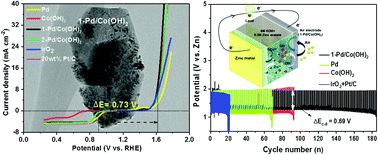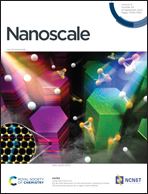Pd nanoparticles deposited on Co(OH)2 nanoplatelets as a bifunctional electrocatalyst and their application in Zn–air and Li–O2 batteries†
Abstract
The development of affordable electrocatalysts for both oxygen reduction and evolution reactions (ORR/OER) has received great interest due to their importance in metal–air batteries and regenerative fuel cells. We developed a high-performance bifunctional oxygen electrocatalyst based on Pd nanoparticles supported on cobalt hydroxide nanoplatelets (Pd/Co(OH)2) as an air cathode for metal–air batteries. The Pd/Co(OH)2 shows remarkably higher electrocatalytic activity in comparison with commercial catalysts (Pt/C, IrO2), including an ORR half-wave potential (E1/2) of 0.87 V vs. RHE and an OER overpotential of 0.39 V at 10 mA cm−2 in aqueous alkaline medium. The Zn–air battery constructed with Pd/Co(OH)2 presents stable charge/discharge voltage (ΔEOER–ORR = 0.69 V), along with durable cycling stability for over 30 h. Also, this cathode exhibits a maximum discharge capacity of 17 698 mA h g−1, and stable battery operation over 50 cycles at a fixed capacity of 1000 mA h g−1, as an efficient air electrode for Li–O2 batteries, indicating that Pd/Co(OH)2 can be a potential candidate for both aqueous and non-aqueous metal–air batteries.



 Please wait while we load your content...
Please wait while we load your content...